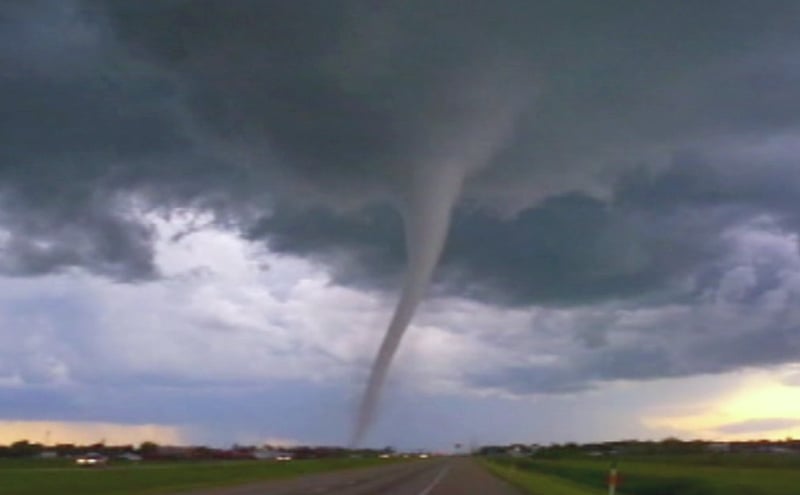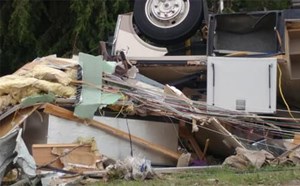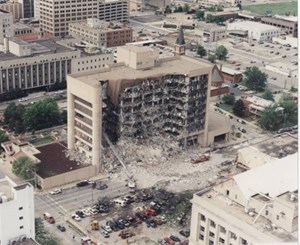
An EF-3 Tornado Directly Impacts a Rural Community
On December 1, 2018 an F3 tornado struck Taylorville, Illinois, a town of 11,200 people located approximately 25 miles southeast of Springfield. A tornado warning was issued at 4:22 pm with a subsequent tornado emergency at 5:15 pm. The tornado reached town at approximately 5:21 pm. Often, warning sirens are only sounded once. However due to the magnitude of the storm traveling towards a populated area an ‘emergency’ was declared. A second sounding may be confused with an all clear, therefore city officials also utilized social media to communicate the severity and urgency of a tornado emergency.
The tornado measured one half mile wide with winds greater than 155 mph and traveled 12 miles directly through the west and north sides of Taylorville.
Approximately 400 homes were damaged but inhabitable, 66 having major damage and 34 being destroyed. An estimated 12-15 victims were entrapped in their homes. There were several downed power lines and disrupted natural gas lines. A mass casualty event was declared approximately 30 minutes after the tornado touched down.
Medical care in Taylorville is provided at a 25-bed critical access hospital, Taylorville Memorial Hospital (TMH), located at the north end of town. There is a 9-bed emergency department staffed with 24-hour single physician coverage and 10-hour advanced practice provider coverage from 11am to 10 pm. It is part of the Memorial Health System (MHS) and associated with Memorial Medical Center, a level 1 trauma center in Springfield. When the mass casualty event was declared the entirety of the MHS was alerted to assist with trauma team activations and interpretation of radiologic studies.
Fortunately, the timing of the tornado occurred around physician sign-out, with the day physician staying to assist with the casualties. Two additional emergency physicians reported to the ED immediately following the event for a total of four in-house ED physicians and a community pediatrician who responded. Air transport was rapidly made available to assist with transfers. Over six hours, the emergency department saw 21 patients and six more were seen the next day for tornado related injuries. A total of three patients were transferred to the neighboring trauma center with two in critical condition. The tornado resulted in no deaths.
While many aspects of the response were excellent, analysis following the event identified several key areas for improvement. While several surrounding agencies responded, it was noted that there were limited resources that affected EMS efficiency in rescue and transport. Individuals who were entrapped or injured in debris required backboards for extended periods of time during extrication and transport. This limited the number of backboards available for EMS providers to use in the field. There were also concerns regarding communication due to a shortage of radios available for internal communication within the hospital. It was also observed that radio calls from the scene were difficult to hear in the emergency department during the event. There was identified confusion about human resource allocation, as there was a large staff response at the hospital that required additional coordination efforts. It was also observed that there were areas to improve in internal patient flow. Additional curtain areas in the preoperative holding area adjacent to the ED were utilized to see patients, but this area was more difficult to access due to limited badge in availability for some staff.
In preparation for future events several changes have been implemented. Additional resources have been made available, including backboards. Additional well-functioning radios have been acquired, and implementation of an improved internal communications system has been developed and will be employed in future mass casualty scenarios. Issues with staff assignments will be improved in future events by employing additional HICS officers and directors to oversee the work force. It has also been suggested that in the event of a repeat mass casualty incident that specific areas of the hospital be unlocked for easy access or the door be manually held open to facilitate patient care.
The events of the Taylorville tornado have provided many lessons on management of large scale catastrophes in a resource limited community. The response of local EMS providers, hospital staff and local physicians was excellent and crucial to the survival and recovery of those affected by the tornado’s damage. The post-event analysis has been key to the efforts made to improve community practice in the event of future disasters, and in the event of a repeat mass casualty incident, the community of Taylorville will be ready.
James Hart MD PGY-2
Department of Emergency Medicine
James Waymack MD FACEP
Southern Illinois University School of Medicine



